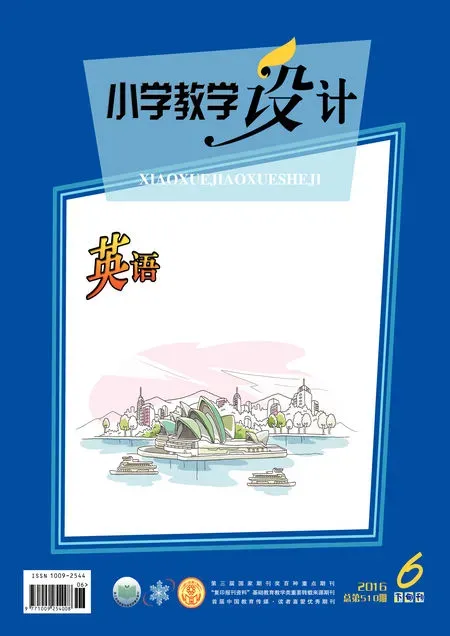修订版PEP 三(下)Unit 6 How many?Part A
陆勤芳
教学过程
Step 1.Warm-up&Revision
1.Free talk
T:Hello,boys and girls!Welcome to my English class.I’m Ricky!
What’s your name?/How old are you?/Do you like...?
S1:I’m Lucy.
S2:I’m 10...
2.Introduce Zhang Peng to Ss.(人机对话)
T:Who is he?
Ss:He is Zhang Peng.
T:Yes! He is our friend Zhang Peng.Say “Hello”to Zhang Peng.
Ss:Say and wave hands to Zhang Peng.Then listen to Zhang Peng.(PPT播放Zhang Peng介绍自己并告诉大家今天是他的生日。)

设计意图:《英语课程标准》中提到“教师应尽量创设真实的语境让学生去交流”。通过创设“人机对话”的模拟场景,使学生感受交流的真实性,而不只是一味地看图片、看信息,丧失使用语言的机会。
3.(1)T:TodayisZhang Peng’s birthday.Let’s sing a song for him,OK?
(T& Sssing“Ten little candles”together.)
设计意图:以给Zhang Peng唱生日祝福歌为契机,在歌曲中复习数字1-10及单词candles。
(2) T:Doyoulikethe song?What can you see in the song(视频版)?
Ss:Yes!We can see many candles.
(出示本课评价方式:奖励物品“蜡烛卡片”。)
T:Look! Do you want to get the candle cards?Then,you should be active and great,OK?

Ss:OK!
设计意图:利用生日蜡烛卡片作为奖励,既贴合本节课创设的情境,同时也为板书简笔画“蛋糕”做补充。此外,颜色鲜艳的蜡烛卡片能吸引三年级学生的注意力,他们为了得到卡片而在课堂上大胆地表现自己。
4.请学生看一看、说一说Zhang Peng收到了哪些礼物。
T:Today is Zhang Peng’s birthday.Is he happy?Because he got many presents.What can you see on the table?
Ss:(Look and say.e.g:I see pencils, ducks, birthday cards...)
设计意图:利用三(上)Count and say的活动形式,调动学生已有的单词储备。
5.请学生注意其中的一张“生日卡片”。
T:What’s this?Is that one a birthday card? (边看PPT边圈出那个“卡片”,引起学生的注意。)
Ss:Look and guess.
(学生注意到那张“卡片”。预设一:学生可能会说:Yes,it is.预设二:学生说:No!:It’s a book./It’s a picture...)

设计意图:在这里巧妙地设计了“是生日卡片还是照片”的疑问,为后面文本中“No,the black one is a bird.”的理解和学习埋下相似的情境伏笔。
6.T:Let’s get it closer and closer.Is it a birthday card?(慢慢将图片放大。)
Ss:No,it’saphoto(picture).
Step2.Presentation&Learning the dialogs
1.师生谈论这张照片。
T:Oh,it’s a photo of Zhang Peng.What do you see in the photo?
Ss:(Talk in pairs,then answer.)I see birds,fish,balloons...
2.引导学生注意照片中的天空部分(被马赛克遮住)。
T:What’s that in the sky?
预设一:学生因看不清楚,不知道答案。
预设二:学生大胆猜测,如birds,cloud,kites。

设计意图:照片中天空的部分被加上马赛克,成功地引起了学生的好奇和猜疑,学生在听课文录音时目的性会更明确,注意力会更集中。
3.我建议去问Zhang Peng。
T:Let’s listen to Zhang Peng.What does he see in the sky?
4.听课文录音,回答问题。
Q:What do they see in the sky?A.Birds(鸟图片)
B.Kites(风筝图片)
学生听录音,回答问题:B.Kites(Kites的发音需要教师带读,学生跟读Kites。)
5.出示文本Zhang Peng和Amy看风筝的场景图。
(1)T:Wow,they see many kites.Do you like flying kites?Are the kites beautiful?(学生看场景图,并和教师进行Free talk。)
Ss:Yes,I do./Yes,they are beautiful.
T:Is the tree beautiful?
Ss:No,it isn’t.
T:Are the flowers beautiful?

Ss:Yes,they are.(PPT出示beautiful,并通过图片对比加深学生对其含义的理解,教师带读,请读得好的学生示范朗读并带读。)
设计意图:利用文本场景图和学生交流,自然引发学生对风筝的称赞:Beautiful!通过带读、学生示范朗读、学生跟读来加强该词发音的准确度。
(2)T:How many (kites)do you see?(出示句型卡并贴到黑板上)Can you count and say like this?(PPT同时出示句型:1,2...I see...!)
Ss:伸出手,指着图片用该句型数并回答。
结果一:学生数11只。
结果二:学生数12只。

设计意图:通过数一数场景图中风筝数量的方式,让学生体会句型“1,2...I see...!”的使用。
(3)T:(假装数12个)But I see 12.How about Zhang Peng?Does he see 11 or 12?Please watch a video of him.
设计意图:利用与学生数风筝不同的结果——到底是11只还是12只,再次引起学生有目的地观看文本视频。
6.播放课文视频,回答问题:How many kites do they see?
学生看视频,尝试回答:eleven(11)。
7.利用PPT呈现小黑鸟飞近天空中的风筝的动态效果。
T:Is that black one a kite?
Ss:No,it’s a bird.
带领学生理解,并用夸张的语气示范读:No,the black one is a bird.
Ss模仿教师夸张的语气再读一遍。
男、女生读;请读得好的学生带读。
8.播放课文录音,学生跟读。
9.男生模仿Zhang Peng读,女生模仿Amy读。
10.同桌分角色朗读课文并表演。
11.学生展示表演时,PPT呈现出课文图片和原文句子提示。原文重点句子部分打上马赛克,给学生增加一点难度。

设计意图:“跳一跳,够得着”,给文本的重点部分打上马赛克,既避免了学生在表演时可能因为紧张而遗忘,也不会因直接看着文本朗读而失去挑战性。
Step 3.Consolidation
游戏:考眼力
T:It’s the birthday party time! Would you like to play a game?
1.How many balls do you see?
2.How many cars do you see?
3.How many balloons do you see?
(学生每次需在5秒钟内记住有多少个气球、皮球和玩具小汽车。)
Ss:快速看图数数并回答。
A.I see 10.B.I see 12.
C.I see 11.
(核对答案,全班一起观看PPT数并运用句型:1,2...I see...!同时教师用蜡烛卡片及时奖励答对的学生。)
设计意图:通过问题的呈现,使学生初步感知“How many+可数名词的复数形式”这个结构。同时,巩固本课所学重点句型“How many...?1,2...I see...! ”以及 10、11、12 的英文表达。
Step 4.Extension
1.T:Zhang Peng is making a birthday wish!Let’s listen:I wish I can go and visit Ricky’s school.(播放录音。)
2.观看学校的一段欣赏片。
T:What do you see in my school?
学生带着小问题观看后,说一说他们看到了什么。
Ss:I see trees, flowers,cars,books...
3.Show one of the photos of my school.教师先就其中的一张照片和学生做示范。
e.g:T:Look at the tree!
S1:Wow,so beautiful!
S2:Wow,so big!
S3:...
T:(做请全班学生回答的手势)How many (trees)do you see?
Ss:1,2...I see 1! (教师和全班学生一起说。)

设计意图:在低年级英语课堂上,教师的示范不仅减少了教师琐碎的课堂用语,更直观地为学生的操练起到很好的辅助作用。
4.两人一组,手拿练习纸,从中任意选择一幅场景和同伴交流。
5.Show time.请坐在下面的学生说一说上台展示的同学描述的是哪一幅图,并且为该生评价。
T:Which pictures are they talking about?How many candle cards can they get?One or two?/What do you think of them?
Ss:Two/One/Three...
T:Congratulations!2 cards for you!

设计意图:在学生上台展示的时候,班上其他学生往往会处于无作为状态。因此,要求他们猜测上台展示的同学描述的是哪一幅图。这不仅吸引了学生在该环节的注意力,同时也是对他们听力的训练。此外,关注课堂上的生生评价同样重要。
Step 5.Sum-up
1.请学生为教师画在黑板上的蛋糕插上生日蜡烛。
T:You did a very good job! And today is my birthday,too.Can you put your“candles”for me?(指着黑板上的蛋糕简笔画。)
Ss:Yes.
T:Thankyou.Andhow many candles do you have?(Part B Let’s talk 重点句型的提前小铺垫。)
S1:I have 4...
S2:I have 6...
T:How old am I?
(师生指着黑板上贴的蜡烛卡片一起数一数:One,two,...twenty-eight.)
T:Yes,I’m 28 years old.Thank you!You are so sweet.
设计意图:将“过生日”的情境贯穿整节课,让评价手段更具实效性。
2.将准备好的彩色小绘本“How many?”作为礼物送给学生。
T:Today,I also bring you some picture books.Please read and share it with your friends.
设计意图:该绘本生动有趣,是学生学习本单元很好的学习资料。绘本内容与本课的学习进行了有效衔接,既巩固本课所学内容,又为学生提供了英语阅读的机会。
Step 6.Homework
Read the picture books with your classmates and parents.
附:板书设计


